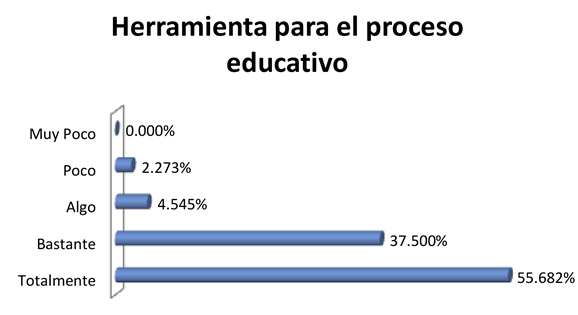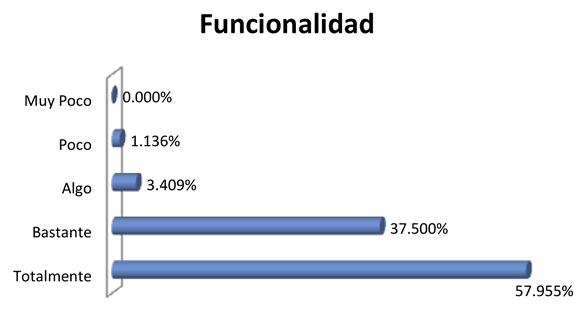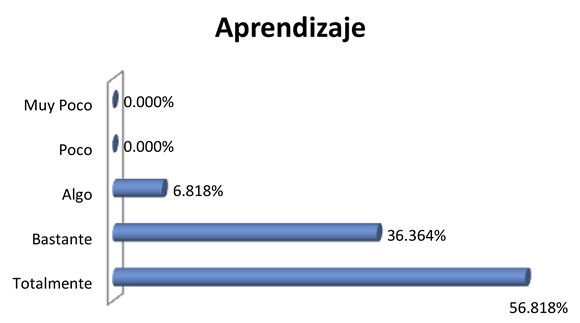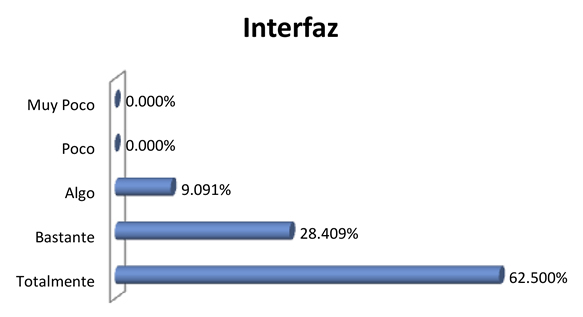
Fuente: Own elaboration, 2017.
doi.org/10.15198/seeci.2017.44.115-126
RESEARCH
APPLICATION IN THE CLOUD LUCIDCHART: A TOOL NEEDED FOR THE INNOVATION OF THE EDUCATIONAL PROCESS IN THE 21ST CENTURY?
APLICACIÓN EN LA NUBE LUCIDCHART: ¿HERRAMIENTA NECESARIA PARA LA INNOVACIÓN DEL PROCESO EDUCATIVO EN EL SIGLO XXI?
APLICAÇÃO NA NUVEM LUCIDCHART: FERRAMENTA NECESSÁRIA PARA A INOVAÇÃO DO PROCESSO EDUCATIVO NO SÉCULO XXI?
Ricardo Adán Salas Rueda1
José De Jesús Vázquez Estupiñán2
1University La Salle. México.
2José De Jesús Vázquez Estupiñán: University La Salle. México.
ABSTRACT
The development of digital tools is causing significant changes in teaching and learning. In particular, this mixed research evaluates the impact of the cloud application Lucidchart to describe the functioning and behavior of IT systems through the development of UML (Unified Modeling Language) diagrams. The sample is composed of 22 students who study the course Application Development at the University La Salle Campus Mexico City during the 2017 school year. This quantitative and qualitative study analyzes this software considering the aspects of functionality, learning, tool for the educational process, interface and service on the network. In conclusion, this research recommends the cloud applications available on Google Drive as Lucidchart for the purpose of building innovative educational experiences.
KEY WORDS: ICT; Learnšing; Higher education; Technology; Cloud service; Lucidchart; Educational experience.
RESUMEN
El desarrollo de las herramientas digitales está provocando cambios significativos en la enseñanza y el aprendizaje. En particular, esta investigación mixta evalúa el impacto de la aplicación en la nube Lucidchart para describir el funcionamiento y comportamiento de los Sistemas Informáticos a través de la elaboración de los diagramas UML (Unified Modeling Language). La muestra está compuesta por 22 estudiantes que cursan la asignatura Desarrollo de aplicaciones en la Universidad La Salle Campus Ciudad de México durante el ciclo escolar 2017. Este estudio de corte cuantitativo y cualitativo analiza este software considerando los aspectos de funcionalidad, aprendizaje, herramienta para el proceso educativo, interfaz y servicio en la red. En conclusión, esta investigación recomienda las aplicaciones de la nube disponibles en Google Drive como Lucidchart con la finalidad de construir innovadoras experiencias educativas.
PALABRAS CLAVE: TIC; Aprendizaje; Educación superior; Tecnología; Servicio en la nube; Lucidchart; Experiencia educativa.
RESUME
O desenvolvimento das ferramentas digitais está provocando mudanças significativas no ensino e na aprendizagem. Em particular, esta investigação mista avalia o impacto da aplicação na nuvem Lucidchart para descrever o funcionamento e comportamento dos Sistemas Informáticos através da elaboração dos diagramas UML (Unifield Modeling Language). A amostra esta composta por 22 estudantes que fazem o curso de Desenvolvimento de Aplicações na Universidade da Salle Campus Cidade do México durante o curso escolar de 2017.
Este estudo de corte quantitativo e qualitativo analisa este software considerando os aspectos de funcionalidade, aprendizagem, ferramentas para o processo educativo, interface e serviço na rede. Concluindo, esta investigação recomenda as aplicações da nuvem disponíveis no Google Drive como Lucidchart com a finalidade de construir inovadoras experiências educativas.
PALAVRAS CHAVE: TIC; Aprendizagem; Educação superior; Tecnologia; Serviço na nuvem; Lucidchart; Experiência educativa
Recibido: 10/05/2017
Aceptado: 20/07/2017
Publicado: 15/11/2017
Correspondencia: Ricardo Adán Salas Rueda
ricardo.salas@ulsa.mx
José De Jesús Vázquez Estupiñán
jjesus.vazquez@ulsa.mx
1. INTRODUCTION
The 21st-century society demands a new model characterized by the educational, institutionalized and systematic training of the teacher (Bennett, Dawson, Bearman, Molloy and Boud, 2017, Delgado, Casado and Lezcano, 2016, Núñez, Conde, Ávila and Mirabent, 2015.). In fact, the educational challenges involve the training of teachers in the area of technology to facilitate the incorporation and management of digital tools (Acosta, 2017, Tarling and Ngambi, 2016).
Today, universities are promoting the development of digital tools-based initiatives for teaching and learning (Bennett, Agostinho and Lockyer, 2017, Subramaniam, 2016, Uluyol and Sahin, 2016).
According to Fuentes, Moreno, Lara and Jiménez (2017, p. 33), educational innovation is understood as “a change that means progress, improvement and enrichment of the curriculum with support in research and in educational technology”.It is worth mentioning that the use of Information and Communication Technologies (ICTs) in the educational field are promoting the design and creation of new virtual learning environments (Acosta, 2017, Soto and Torres, 2015, Williams and Otrel, 2017)
According to Acosta (2017: 128), ICTs are “those tools, devices, programs and technological applications used in the classroom, both by teachers and students, with a purely pedagogical purpose and methodologies that allow the achievement of the expected learning “.
It is worth mentioning that educational institutions are promoting the design and implementation of various web applications and teaching systems to meet the demands of the productive environment and to develop students’ digital competency (Albertos, Domingo and Albertos, 2016; González y Martínez, 2017). In particular, one of the innovative tools used by organizations is applications in the cloud (Joyanes, 2012, Sevillano and Beltran, 2014 and Sosinsky, 2011).
According to Fuentes, Moreno, Lara and Jiménez (2017, p. 33), the curricular innovation Cloud Computing makes it possible “to design, develop and evaluate components of the curriculum such as curriculum programs, study guides, materials and educational programs in general, incorporating resources of computing in the cloud and considering at least the model of Software as a Service.” However, services in the cloud are scarcely used in the educational field by students (Fuentes, Moreno, Lara and Jiménez, 2017). Therefore, this piece of research evaluates and analyzes the incorporation of the application in the cloud Lucidchart in the subject Development of Applications in order to improve teaching-learning conditions.
2. OBJECTIVES
The objectives of this quantitative and qualitative piece of research are:
1. Analyze the Lucidchart application as a useful, innovative, necessary and relevant tool in the course development of Applications
2. Evaluate the use of the Lucidchart application to facilitate access and management of resources, use of various mobile devices and storage of information in the course Development of Applications
3. Analyze the impact of the Lucidchart application on learning during the development of class diagrams, packages, use cases and activities
4. Determine the characteristics of the Lucidchart interface
5. Evaluate the service of the cloud Lucidchart in the subject Development of Applications
3. METHODOLOGY
This piece of research uses a mixed approach with the purpose of evaluating the impact of the service of the cloud Lucidchart during the development of the Unified Modeling Language (UML) diagrams in the course Development of Applications. Note that this software is located in Google Drive. The sample is made up of 22 students who are studying the course Business Management and Information Technologies at La Salle University Campus Mexico City during the 2017-1 school year.
For 4 weeks, these students used the Lucidchart application to describe the operation of ERP (Enterprise Resource Planning) and CRM (Customer Relationship Management) systems by building class diagrams, packages, use cases and activities. Subsequently, a questionnaire was applied to compile the data of this mixed piece of research.
With regard to the quantitative approach, the variables used to analyze Lucidchart software are:
1. Tool for the educational process: useful, innovative, necessary and relevant
2. Functionality: access and management of resources, use of various mobile devices and storage of information
3. Learning: development of class diagrams, packages, use cases and activities
4. Interface: simple, fast, pleasant and understandable
It should be mentioned that the categories used to evaluate these quantitative variables are Totally, Fairly, Somewhat, Little and Very Little. On the other hand, the qualitative approach evaluates aspects of this service in the cloud related to the motivation and improvement of the teaching-learning process, the assimilation of knowledge and the development of skills.
4. DISCUSSION
Table 1 shows the results on the use of the application in the cloud Lucidchart in the educational context.

Fuente: Own elaboration, 2017.
According to the 50.00% of the university students, the Lucidchart application is totally useful in the subject Development of Applications. Also, 54.55% of respondents consider this service in the cloud to be totally innovative for the Bachelor’s Degree in Business Management and Information Technologies.
Even Table 1 shows that the majority of students (59.09%) state that this software is totally necessary and relevant to the teaching-learning process.
It is worth mentioning that the participants’ preference for the use of Lucidchart’ as a tool for the educational process is located in the category Totally with 55.68.2% (See Chart 1).
Gráfico 1: Lucidchart as a tool for the educational process.

Sources: Own elaboration, 2017.
Table 2 shows the results on the Functionality of the Lucidchart application during the realization of the teaching-learning process.
Tabla 2 Funcionalidad

Fuente: Sources: Own elaboration, 2017.
54.55% of the students indicate that Lucidchart totally facilitates access to the resources and storage of information in the subject of Development of Applications. Also, 63.64% of participants consider that this service in the cloud totally allows the use of various mobile devices for learning. It is worth mentioning that 100.00% of university students are in the categories Totally and Fairly regarding the aspect of resource management (See Table 2).
In general, students of the Bachelor’s Degree in Business Management and Information Technologies affirm that the Functionality of Lucidchart totally (57.955%) and fairly (37.500%) facilitates the educational process (See Chart 2).
Gráfico 2: Funcionalidad de Lucidchart. Sources: Own elaboration, 2017.

Table 3 shows the results on the impact of the Lucidchart application on learning during the development of UML diagrams.
Table 3 Aprendizaje

Fuente: Sources: Own elaboration, 2017.
It is worth mentioning that the service in the cloud Lucidchart is used in the course Development of Applications to describe the operation and behavior of ERP and CRM computer systems.
In fact, Table 3 shows that the highest preference of students is in the category Totally for the elaboration of class diagrams (50.00%), packages (59.09%), cases (63.64%) and activities (54.55%).
Regarding the use of Lucidchart in learning, Chart 3 shows that 56.81.8% of students are in the Totally category and 36.364% in the Fairly category.
Chart 3: Use of Lucidchart in learning.

Source: Made by the authors, 2017.
Table 4 shows the results of the application design in the cloud Lucidchart.
Table 4 Interfaz

Source: Own elaboration, 2017.
59.09% of university students state that the Lucidchart interface is totally simple and fast for the teaching-learning process. Similarly, 63.64% of participants consider this application to be completely understandable. It is worth mentioning that the highest preference is present in the pleasant aspect with 68.18% (See Table 4).
Chart 4 shows that 62.50% of students consider Lucidchart’s interface to be totally simple, fast, pleasant and understandable. In addition, 28.409% of students studying the course Development of Applications fall into the Fairly category and 9,091% of participants are in the Somewhat category.
Chart 4: Lucidchart application interface.

Source: Made by the authors, 2017.
The results of this qualitative piece of research on the use of Lucidchart software in the course Development of Applications during the 2017-1 school year are shown below.
The use of Lucidchart to facilitate the assimilation of knowledge has favorable comments:
“It’s easier to learn with diagrams” (Student, Male, 22 years old)
“Yes, because it organizes the information” (Student, Male, 21 years old)
“Yes, because it allows us to use the program from any location” (Student, Male, 22 years old)
“Yes, since diagrams are a very easy study tool” (Student, Female, 20 years old)
The design, features and functions of this service in the cloud motivate student learning:
“Yes, because in a certain way it allows me to develop my skills and abilities in the new platforms” (Student, Male, 20 years)
“Yes, it’s a way to know different platforms” (Student, Female, 21 years old)
“Yes, it’s a new tool” (Student, Male, 23 years old)
“Yes, it’s interactive” (Student, Male, 20 years old)
“Yes, because the service facilitates learning” (Student, Male, 22 years old)
Similarly, the Lucidchart application has favorable comments regarding the teaching-learning process:
“Yes, because it’s easier to learn and teach through diagrams” (Student, Female, 20 years)
“Yes, because it’s a more pleasant way to learn” (Student, Male, 22 years old)
“Yes, since we can apply everything learned in the program” (Student, Male, 22 years old)
“Yes, it helps us to understand it through diagrams” (Student, Male, 21 years old)
“Yes, because it saves everything automatically and that favors” (Student, Female, 21 years old)
Finally, university students point out that this software facilitates the development of skills:
“Yes, using the tools provided” (Student, Female, 21 years old)
“Yes, because it has helped us develop useful skills for UML” (Student, Male, 21 years old)
“Yes, because it helps the creative process” (Student, Male, 22 years old)
“Yes, because we share everything more easily” (Student, Female, 21 years old)
5. CONCLUSIONS
Universities must adapt to the new conditions presented by the Society of the 21st Century. Therefore, teachers need to be trained in issues related to the use of Information and Communication Technologies.
In particular, this mixed piece of research proposes the use of the Lucidchart application to facilitate the analysis of computer systems through the elaboration of UML diagrams.
The results obtained allow us to affirm that this service in the cloud is a useful, innovative, necessary and relevant tool during the teaching-learning process. In addition, this software allows students to access and manage resources, to use various mobile devices and to store information.
It is worth mentioning that the interface of the Lucidchart application is simple, fast, pleasant and understandable. Consequently, it is a technological alternative suitable for the educational field. In fact, the qualitative approach indicates that this software facilitates the assimilation of knowledge, fosters the development of abilities and motivates learning in the students.
In conclusion, teachers have the opportunity to innovate the educational process through the use of the cutting-edge technology. In particular, this study recommends the incorporation of the service in the cloud Lucidchart in computer-related college degrees.
6. REFERENCES
1. Acosta Aguilera, A. L. (2017). Uso e integración de las TIC. Una mirada desde las aulas de Educación Normal. En R. López González, D. Hernández y A. J. Bustamante Santos, Las tecnologías digitales en los contextos educativos: la voz de los estudiantes (pp. 123-142). Córdova, Argentina: Editorial Brujas.
2. Albertos, A., Domingo, A. y Albertos, J. E. (2016). Estrategia docente para el desarrollo de la competencia digital en el aula universitaria. Educar, 52(2), 243-261. doi: http://dx.doi.org/10.5565/rev/educar.732
3. Bennett, S., Agostinho, S. y Lockyer, L. (2017). The process of designing for learning: understanding university teachers’ design work. Educational Technology Research and Development, 65 (1), 125–145. doi:10.1007/s11423-016-9469-y
4. Bennett, S., Dawson, P., Bearman, M., Molloy, E. y Boud, D. (2017). How technology shapes assessment design: Findings from a study of university teachers. British Journal of Educational Technology, 48(2), 672–682. doi:10.1111/bjet.12439
5. Delgado Benito, V., Casado Muñoz, R. y Lezcano Barbero, F. (2016). La formación permanente del profesorado universitario en el EEES: Un estudio en la Universidad de Burgos. Revista d’innovació educativa, 17, 30-40. doi: 10.7203/attic.17.9105
6. Fuentes Martínez, A., Moreno Olivos, T., Lara Villanueva, R. S. y Jiménez Salazar, H. (2017). Experiencias con tecnologías colaborativas de Cloud Computing para la universidad. En C. R. Jaimez González, K. S. Miranda Campos, E. Vázquez Contreras y F. Vázquez Vela, Estrategias didácticas en educación superior basadas en el aprendizaje: innovación educativa y TIC (pp. 25-45). Ciudad de México, México: UAM Unidad Cuajimalpa.
7. González, J. y Martínez, F. (2017). La percepción de los estudiantes acerca de la presencia de las TIC en la universidad. Revista Electrónica de Tecnología Educativa, 59, 1-15. doi: http://dx.doi.org/10.21556/edutec.2017.59
8. Joyanes Aguilar, L. (2012). Computación en la nube. Ciudad de México: Alfaomega.
9. Núñez, L., Conde, S., Ávila, J. A. y Mirabent, M. D. (2015). Implicaciones, uso y resultados de las TIC en educación primaria. Revista Electrónica de Tecnología Educativa, 53, 1-17. doi: http://dx.doi.org/10.21556/edutec.2015.53
10. Sevillano Jaen, F. y Beltrán Pardo, M. (2014). Cloud computing, tecnología y negocio. Madrid: Paraninfo.
11. Sosinsky, B. (2011). ¿Qué es la nube?: el futuro de los sistemas de información. Madrid: Anaya Multimedia
12. Soto Ortiz, J. L. y Torres Gastelú, C. A. (2015). Apreciaciones sobre el diseño colaborativo de redes de datos mediante TIC. Revista Electrónica de Tecnología Educativa, 51, 1-15. doi: http://dx.doi.org/10.21556/edutec.2015.51
13. Subramaniam, K. (2016). Teachers’ Organization of Participation Structures for Teaching Science with Computer Technology. Journal of Science Education and Technology, 25(4), 527–540. doi: 10.1007/s10956-016-9610-z
14. Tarling, I. y Ngambi, D. (2016). Teachers pedagogical change framework: a diagnostic tool for changing teachers’ uses of emerging technologies. British Journal of Educational Technology, 47(3), 554–572. doi:10.1111/bjet.12454
15. Uluyol, C. y Sahin, S. (2016). Elementary school teachers’ ICT use in the classroom and their motivators for using ICT. British Journal of Educational Technology, 47(1), 65–75. doi:10.1111/bjet.12220
16. Williams, J. y Otrel Cass, K. (2017). Teacher and student reflections on ICT-rich science inquiry. Research in Science & Technological Education, 35(1), 88-107. doi: http://dx.doi.org/10.1080/02635143.2016.1248928
AUTHORS
Ricardo Adán Salas Rueda
Doctor of Design of New Technologies from the Autonomous Metropolitan University (UAM) in 2014. Professor and researcher at the Faculty of Business of La Salle Campus University in Mexico City. For 15 years he has taught several courses on technology, management, education and mathematics at the level of bachelor’s degree and graduate courses. He is a candidate to national researcher for the period of time from January 1, 2016 to December 31, 2018 by the National System of Researchers (SNI). He is a leader of the Group for Research, Development and Innovation (GIDI) “Usable Systems”. He is responsible for the Project EDU-04/16: Design and implementation of usable educational web systems for the mass online and open courses (MOOC) considering the use of Big data.
José De Jesús Vázquez Estupiñán
Bachelor of Management of Companies and Journalism. He has taken a graduate course on High Management from IPADE. He has a master’s degree in Law from UNAM and a doctor’s degree in Education from La Salle University. He has taken a post-doctorate course in School of Education from Texas ABM University College Station. In addition to holding several managerial positions at the University, he was Rector of La Salle Morella University until 2011. He is founding member of the Young La Salle Movement: He is a member of the Secretariat of Young in the Government of Michoacán and is currently Head of the Faculty of Business of La Salle University in Mexico.